|
|
|
Sort Order |
|
|
|
Items / Page
|
|
|
|
|
|
|
| Srl | Item |
| 1 |
ID:
099774
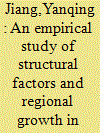

|
|
|
|
|
| Publication |
2010,
|
| Summary/Abstract |
Based on data of 31 Chinese provinces over the period 1980-2004, the study in this paper presents new evidence on the effects of structural shocks and structural transformation on growth and convergence among the Chinese regions. The division of overall regional growth in labour productivity into three components - growth due to structural shocks, growth due to structural transformation and a 'residual' indicating growth due to region-specific changes - provides us with a better framework than the traditional one-sector Solow growth model for attributing growth and convergence to various different sources. Among other findings, the study has shown that during 1990-1999, structural shocks worked to widen the gap between rich regions and poor regions in China, while structural transformation worked to narrow the gap.
|
|
|
|
|
|
|
|
|
|
|
|
|
|
|
|
| 2 |
ID:
099773
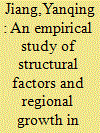

|
|
|
|
|
| Summary/Abstract |
Based on data of 31 Chinese provinces over the period 1980-2004, the study in this paper presents new evidence on the effects of structural shocks and structural transformation on growth and convergence among the Chinese regions. The division of overall regional growth in labour productivity into three components - growth due to structural shocks, growth due to structural transformation and a 'residual' indicating growth due to region-specific changes - provides us with a better framework than the traditional one-sector Solow growth model for attributing growth and convergence to various different sources. Among other findings, the study has shown that during 1990-1999, structural shocks worked to widen the gap between rich regions and poor regions in China, while structural transformation worked to narrow the gap.
|
|
|
|
|
|
|
|
|
|
|
|
|
|
|
|
| 3 |
ID:
178417
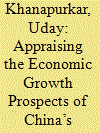

|
|
|
|
|
| Summary/Abstract |
This article examines the economic growth prospects of China’s services sector. Reportage on China’s economy and its data releases tends to focus largely on aggregate GDP growth, manufacturing growth, retail sales and investments, and fails to adequately cover services despite them being the largest contributor to growth. The article parses the growth of China’s various services subcomponents across a range of parameters and assesses that the industry has come under duress with a slowdown in complementary manufacturing and the dissipation of growth bubbles in finance and real estate. It is further observed that reforms necessary for spurring services growth are at a nascent stage, proceed slowly, and are imperilled by GDP growth targets that result in policies favouring the manufacturing industry. In sum, while China’s services growth prospects are hardly in dire jeopardy due to favourable demand-side conditions, achieving potential and affecting convergence with high income countries will necessitate the expedition of reforms and the engineering of a sustained high growth phase in the sector.
|
|
|
|
|
|
|
|
|
|
|
|
|
|
|
|
| 4 |
ID:
109904


|
|
|
|
|
| Publication |
2012.
|
| Summary/Abstract |
This paper discusses the growth differentials between Chinese provinces geared to agricultural activities and those that have focused on industrial production over three decades of economic reform. Following Hansen and Prescott's (2002) model, we suggest that the differences between regions stem from the resource allocation in place at the beginning of the reform process. We show that provinces with high initial shares of industrial production (the industrial club) have converged, and that agricultural provinces that have shifted to industrial production have been catching up with provinces that were industrialized at the outset. Provinces that have clung to an agricultural strategy (the agricultural club) show no evidence of convergence and appear to have been left behind in terms of economic development.
|
|
|
|
|
|
|
|
|
|
|
|
|
|
|
|
| 5 |
ID:
059680
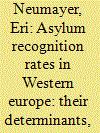

|
|
|
| 6 |
ID:
168860
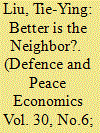

|
|
|
|
|
| Summary/Abstract |
This study applies the Sequential Panel Selection Method (SPSM), to investigate the convergence properties of the military expenditure of the North Atlantic Treaty Organization (NATO) during the period of 1990–2015. Compared to the traditional methods, SPSM considers fundamentally general spatial homogeneous and heterogeneous relationships with countries and examines the evolution of military expenditure. We find that four-fifths of NATO member countries have been convergent with the UK, but no country’s military expenditure is convergent with the US. This means that there is no significant linkage effect in the US for NATO military expenditure. While they are allies of the US, the majority of NATO member countries’ military expenditures are consistent with UK military expenditure. The main reasons are due to the geographical space layout and the international relationship convergence. The results indicate that more than four-fifths of NATO member countries have been coordinated with convergence theory and spillover effect.
|
|
|
|
|
|
|
|
|
|
|
|
|
|
|
|
| 7 |
ID:
162355
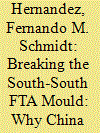

|
|
|
|
|
| Summary/Abstract |
China and New Zealand were able to sign a Free Trade Agreement (FTA) in 2008, in spite of the large differences in standards under which they were respectively negotiating trade agreements in the international arena. This article starts with a descriptive analysis of these differences between each country’s standards in terms of FTA quality. With the description of these standards, which seem to stand on opposite sides of a continuum, we examine why China and New Zealand decided to forego the standards under which they had negotiated previous agreements in order to find a middle ground. This process of convergence showcases how the interests of both parties moved them towards the adoption of a middle ground which enabled them to negotiate a win-win agreement.
|
|
|
|
|
|
|
|
|
|
|
|
|
|
|
|
| 8 |
ID:
186172
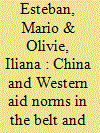

|
|
|
|
|
| Summary/Abstract |
Despite considerable debate on the normative foundations of Chinese international development cooperation and how they compare with those of traditional donors,positivist studies on the normative consequences of China’s socialization into mainstream international norms of development assistance are scarce. This article explores this topic for the case of Ethiopia, an aid ‘darling’ with an extended presence of Chinese and Western development actors, taking the Aid Effectiveness Agenda as reference. Resorting to official documents, data analysis, and semi-structured interviews, the authors find that Chinese development actors’ understanding of ownership and transparency is relatively stable and different from that of Western donors and that they promote their own understanding of those principles among Ethiopian stakeholders. There are, however, significant changes in inclusive partnerships and the focus on results, that have more to do with a pragmatic adaptation process by Chinese actors than with a socialization process through their interaction with traditional donors.
|
|
|
|
|
|
|
|
|
|
|
|
|
|
|
|
| 9 |
ID:
164059
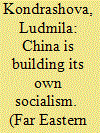

|
|
|
|
|
| Summary/Abstract |
The revolution of 1949 in China marked the country’s transitionfrom “bureaucratic feudalism” to the building of socialist society. The begin-ning of the policy of reforms (1978-1979) is now interpreted as “another rev-olution” – a transition from “state socialism” to “market socialism.” Judgingby the decisions of the 19th CPC Сongress, at present China begins a newstage of socioeconomic development aimed at combining the personal inter-ests of its citizens with public and state interests. The new stage of reforms canbe characterized as the “third Chinese revolution” with very important conse-quences for the entire social structure of the country. The Chinese multilayeredmarket economy will correspond to a mixed political system that features acombination of strong centralized power with party-and-government manage-ment and democratic methods of administration at a lower level.
|
|
|
|
|
|
|
|
|
|
|
|
|
|
|
|
| 10 |
ID:
169894
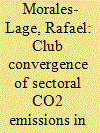

|
|
|
|
|
| Summary/Abstract |
An understanding of the evolution of sectoral CO2 emissions for all EU countries in recent decades would clearly be useful for political authorities when designing future environmental policies. This paper investigates the process of convergence in sectoral per capita CO2 emissions, with a focus on the energy sector. The concept of club convergence is used to analyse emissions in 28 EU countries from 1971 to 2012, with special attention paid to the energy subsectors (power generation and heating, manufactures and construction, transportation, and other minor fuel combustion). We find that core European countries (France, the Netherlands, Germany and the UK) are included in the best performing clubs, no matter the sector or subsector, whereas among Central and Eastern European Countries, a few diverge from the average towards higher emissions. Relative convergence among a large number of EU members would, therefore, support the relevance of both the EU abatement policy and international agreements in this process.
|
|
|
|
|
|
|
|
|
|
|
|
|
|
|
|
| 11 |
ID:
109158


|
|
|
|
|
| Publication |
2011.
|
| Summary/Abstract |
Based on quantitative indicators for fifteen advanced countries between 1974 and 2005, and case studies of France, the United Kingdom, Germany, Italy, Sweden, and Ireland, this article analyzes the trajectory of institutional change in the industrial relations systems of advanced capitalist societies, with a focus on Western Europe. In contrast to current comparative political economy scholarship, which emphasizes the resilience of national institutions to common challenges and trends, it argues that despite a surface resilience of distinct national sets, all countries have been transformed in a neoliberal direction. Neoliberal transformation manifests itself not just as institutional deregulation but also as institutional conversion, as the functions associated with existing institutional forms change in a convergent direction. A key example is the institution of centralized bargaining, once the linchpin of an alternative, redistributive and egalitarian, model of negotiated capitalism, which has been reshaped in the past twenty years to fit the common imperative of liberalization.
|
|
|
|
|
|
|
|
|
|
|
|
|
|
|
|
| 12 |
ID:
173392
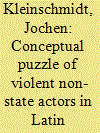

|
|
|
|
|
| Summary/Abstract |
Current research often emphasizes the typological convergence of violent non-state actors, which according to this literature tend to mix the characteristics of actors conventionally understood as criminals, insurgents, terrorists, or warlords. In this article, we examine the adequacy of such proposals to explain the evolution of violent actors in Latin America. Through a comparative study of the long-term development of two important Latin American violent actors, the Colombian FARC and the Mexican Sinaloa Cartel, we arrive at the conclusion that convergence phenomena occur with much less frequency and intensity than suggested, and when they do occur, they are caused by mechanisms typically not considered in the literature. This may indicate a significant limitation regarding the empirical reach of the convergence hypothesis as well as a need for further conceptual clarification.
|
|
|
|
|
|
|
|
|
|
|
|
|
|
|
|
| 13 |
ID:
100381
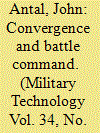

|
|
|
| 14 |
ID:
161811
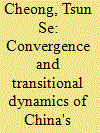

|
|
|
|
|
| Summary/Abstract |
Many scholars have argued that the huge increase in regional inequality in China can be attributed greatly to the disparity in industrialization. This paper contributes to the literature by providing empirical evidence on the transitional dynamics of industrial output by employing a new framework of distribution dynamics analysis, namely, the mobility probability plot (MPP), and a county-level database made up of counties and county-level cities. The new framework can address several inadequacies of the traditional display tools used in the distribution dynamics literature. Stochastic kernel analyses are performed for the nation, the economic zones, and the provinces individually so as to provide an in-depth understanding of the evolution and convergence of industrial output. This study fills the gap in the literature and provides information on mobility of the county-level units, which can greatly aid the policy making process.
|
|
|
|
|
|
|
|
|
|
|
|
|
|
|
|
| 15 |
ID:
150890
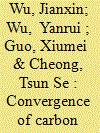

|
|
|
|
|
| Summary/Abstract |
This paper investigates the spatial dynamics of per capita carbon dioxide (CO2) emissions in China. The analyses are conducted by employing a continuous dynamic distribution approach and panel data of 286 cities at the prefecture and above-prefecture level. The results show that per capita CO2 emissions tend to converge during the sample period of 2002–2011. However, multimodality is found in the ergodic distribution of the full sample. It is also found that there is more persistence in cities with low per capita CO2 emissions, and more mobility in cities with high per capita CO2 emissions. The analyses also show that the dynamics of per capita CO2 emissions are significantly different among various geographical, income and environmental policy groups. The conditional distribution analyses indicate that multimodality cannot be explained independently by any one of the two factors, namely geographical location or income level. The findings in this study may have important policy implications for CO2 abatement in China.
|
|
|
|
|
|
|
|
|
|
|
|
|
|
|
|
| 16 |
ID:
186433
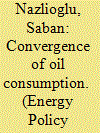

|
|
|
|
|
| Summary/Abstract |
Growing concerns about long-run equilibrium in the oil market have focused on understanding the time path of oil consumption across countries. This study examines the convergence of oil consumption across the largest oil consumers. To this end, we employ the historical oil consumption data dating back to 1890 by benefiting from the newly proposed convergence concepts, including relative/club convergence and weak -convergence, in addition to the conventional β-convergence notion. The empirical results provide new and insightful findings. First, considering common factors in the dynamics of oil consumption leads to convergence. Second, the overall evidence of absolute convergence has been at work among countries mainly before the great depression 1890–1929, while divergence occurs after the mid of 1990s. Third, the divergence observed over the last decades persists even after accounting for either a relative or weak form of convergence, supporting the primary role of the current dynamics in world oil markets. Divergence calls for stricter energy transition policies. Moreover, the clustering algorithm identifies unique convergent clubs, indicating that a unified energy policy is not tenable.
|
|
|
|
|
|
|
|
|
|
|
|
|
|
|
|
| 17 |
ID:
151312
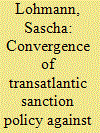

|
|
|
|
|
| Summary/Abstract |
Between 1996 and 2012, cooperation between the United States (US) and the European Union (EU) on Iran sanctions underwent a dramatic shift from open disagreement to almost unanimous consensus. Whereas the US preferred negative sanctions throughout this period, the EU opted at first for using economic incentives and dialogue. The EU’s diverging approach exemplified the overall preference for multilateralism and engagement strategies over unilateral coercive measures. Beginning in 2005, however, European sanction policy towards Iran converged with that of the US. In this article, I argue that the convergence of transatlantic sanction policy against Iran cannot be understood without the pressure employed by Washington. The US pressure campaign consisted of secondary sanctions against European companies. As necessary condition, US pressure has been a key external factor that complemented the EU’s internal developments fostering a more coercive approach towards Tehran after the revelation of the Iranian nuclear programme in 2002 and the breakdown of the E3 (Great Britain, France and Germany) negotiations in 2005.
|
|
|
|
|
|
|
|
|
|
|
|
|
|
|
|
| 18 |
ID:
114656
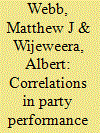

|
|
|
|
|
| Publication |
2012.
|
| Summary/Abstract |
Using a panel data estimation technique, this article examines correlations in party performance in India for political parties that contested legislative assembly and federal parliamentary elections held within the following eighteen months during the period between 1980 and 2009. The results are analysed according to a range of variables, including type of party and voter turnout. The study's finding that, across party types, there is a strong and statistically significant correlation in party performance between the two elections provides empirical corroboration of prior studies that have suggested the existence of enduring linkages between politics at the state and federal levels. It also offers some validation for the popular media's and others' preoccupations with the outcome of legislative assembly elections as indicators of subsequent parliamentary polls.
|
|
|
|
|
|
|
|
|
|
|
|
|
|
|
|
| 19 |
ID:
077807


|
|
|
|
|
| Publication |
2007.
|
| Summary/Abstract |
This article discusses a cross-cultural negotiation process between a new Japanese university and an established American university to create a joint business venture - a dual-degree program. The parties failed to sign a contract, and there were indicators during negotiations pointing to the likelihood of a failed outcome. Negotiation style convergence was evident, with the Japanese adopting an erabi ('either-or') style and the Americans an awase ('more-or-less') style. The 7-Step framework used to structure the negotiation discussion may be better suited to analyzing Japanese negotiation processes than American. The implications will be of value to Japanese and American/Western businesspeople or educational administrators involved in joint venture-type negotiations
|
|
|
|
|
|
|
|
|
|
|
|
|
|
|
|
| 20 |
ID:
128493
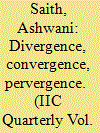

|
|
|
|
|
|
|
|